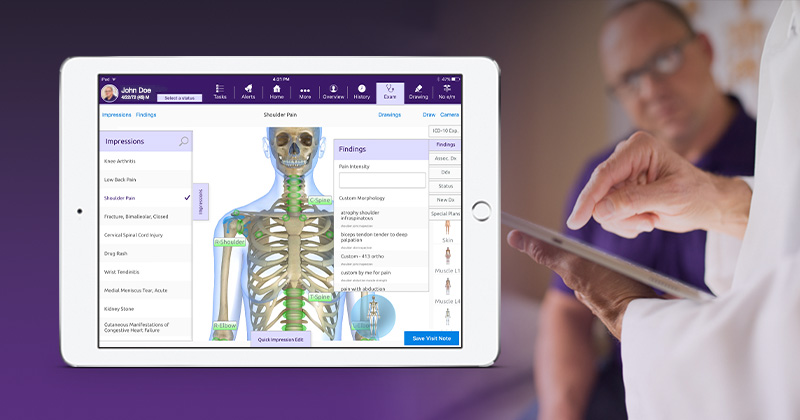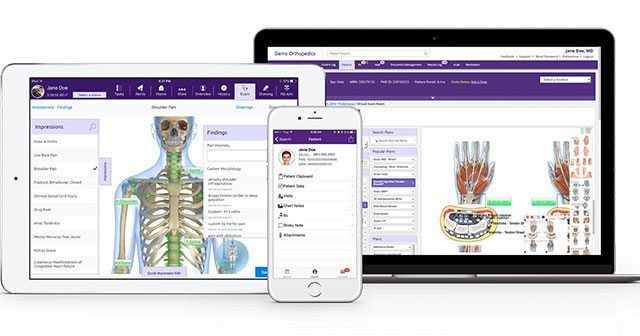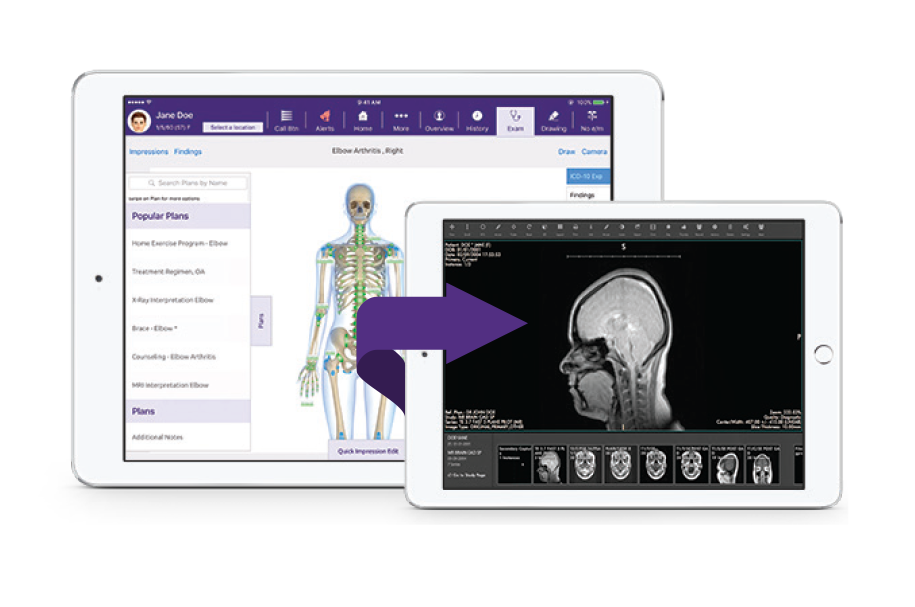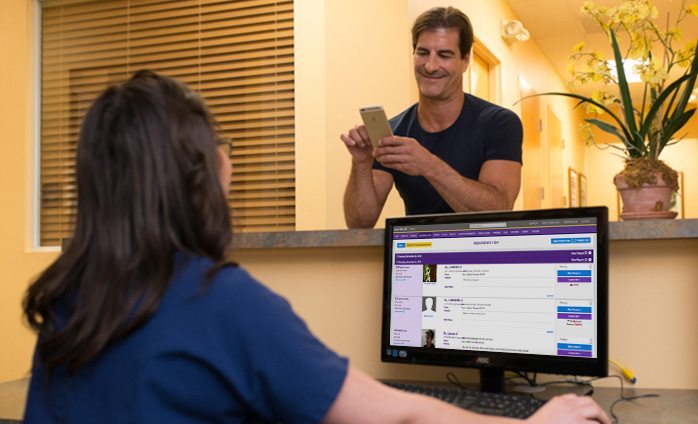Overview of Orthopedic Software

Want to upgrade technology in your office? Here’s what to look for when it comes to your orthopedic EHR system and beyond.
The Foundation: An Orthopedic EHR System
A solid foundation plays an integral role whether it’s for a building, a sport, education and even the tools selected for your practice. Your orthopedic EHR system should come equipped with several features to help provide a strong infrastructure for your practice. Essentially you want software that can help you deliver the best care more efficiently. Here are some of the attributes you should seek in an orthopedic EHR.
- Built-in orthopedic knowledge and workflow – Just as the surgical tools needed for orthopedics vary greatly from those needed for
 ophthalmology, so does the knowledge built in to your EHR system. Make sure the EHR you evaluate comes with orthopedic knowledge out-of-the-box and can adapt to the way you practice and learn your most commonly prescribed medications, for instance. Don’t fall victim to building time-consuming orthopedic templates.
ophthalmology, so does the knowledge built in to your EHR system. Make sure the EHR you evaluate comes with orthopedic knowledge out-of-the-box and can adapt to the way you practice and learn your most commonly prescribed medications, for instance. Don’t fall victim to building time-consuming orthopedic templates. - Merit-based incentive payment system (MIPS) dashboard – With a built-in MIPS intelligence platform, you should collect MIPS data automatically within your existing workflow, track and benchmark your estimated performance and skip manual data and reporting. As regulations continue to evolve, find out what the company of interest has done to keep up – and more importantly stay head of the curve – when it comes to the technology offered.
- Suggested automatic coding – Your orthopedic EHR should help when it comes to suggesting ICD-10, CPT and modifier codes. In addition, it should help you generate thorough notes and bills automatically, allowing you to finish charting while still in the exam room. Suggested automatic coding during the flow of an exam may help you code during your orthopedic visits.
- Orthopedic Interoperability – Your orthopedic EHR should work together with other healthcare IT systems to enhance the overall
 efficiency of your practice. Your orthopedic EHR should electronically share pertinent patient information with your physical therapy and PACS systems to streamline communications and reduce manual processes, helping save valuable staff time and resources.
efficiency of your practice. Your orthopedic EHR should electronically share pertinent patient information with your physical therapy and PACS systems to streamline communications and reduce manual processes, helping save valuable staff time and resources. - Interactive Anatomical Atlas™ – Visuals play an important role in patient education and engagement. Look for a system where you can tap and swipe through interactive visual elements as it will benefit both you and your patients.
- Cloud-based technology – With a cloud EHR system, you can access your information from virtually wherever you are. You’ll eliminate the need for expensive upkeep on physical servers and data will be backed up in the cloud.
- iPad and Desktop accessibility – You don’t want to be relegated to facing a computer screen when treating your patients, so look for an orthopedic EHR system that has a native iPad application and also gives you the option to access data on a desktop. Flexibility is key.
The Connection: Orthopedic Practice Management
 Streamlined communication reigns supreme when it comes to bridging the gap between the front and back offices, making an orthopedic practice management system invaluable. So what should an ideal practice management system bring to the table? It should help you:
Streamlined communication reigns supreme when it comes to bridging the gap between the front and back offices, making an orthopedic practice management system invaluable. So what should an ideal practice management system bring to the table? It should help you:
- Speed up check-in, checkout, billing, scheduling and collections
- Empower staff to speak about charges with straightforward financials
- Measure your business’s health with metrics-driven reports
- Adopt a more comprehensive approach to medical billing
I want to emphasize that utilizing integrated orthopedic EHR and practice management systems can make a world of difference as the information flows seamlessly back and forth between both systems. Instead of working with two different vendors, you have one to contact for your needs. Make a checklist of what you want from an orthopedic practice management system. My suggested checklist would include:
- Ease of use
- Seamless interface with your orthopedic EHR system
- Financial dashboard and custom reporting
- Real-time insurance verification
- Automated suggested coding and orthopedic billing
- Claims scrubbing prior to submission
- Straightforward appointment scheduling
- Ability to accept patient payments
- Enhanced communication across the practice
- Exceptional training, implementation and customer support
Make your list of what your current system may lack and the features on your practice management system wishlist. In addition to speaking directly with the vendor, ask to connect with current clients to learn from their first-hand experiences, too.
The Data Story: Analytics
 Numbers can tell a story. And in medicine, the ability to readily access and view those numbers can help you better manage the clinical, financial and operational health of your practice and patients. You want an integrated analytics solution that can help you answer challenging questions that would be nearly impossible to track if you just had pen and paper. Have you ever wondered…
Numbers can tell a story. And in medicine, the ability to readily access and view those numbers can help you better manage the clinical, financial and operational health of your practice and patients. You want an integrated analytics solution that can help you answer challenging questions that would be nearly impossible to track if you just had pen and paper. Have you ever wondered…
- Where am I referring my complex hand and ankle cases? Is it time to bring them in house?
- Which physical therapists referred the most patients to me?
- How many patients with carpal tunnel syndrome did I order surgery for?
I know I have. Implementing a unified and integrated platform where the entire software suite can communicate makes capturing and decoding this data possible. Harnessing the data you collect with the right orthopedic software can help you improve multiple facets of your practice.
The Money: Revenue Cycle Management
Through my varied experiences I have found that in-house billers and traditional billing services don’t fully address your entire revenue cycle. Let me backup for a second. What is the revenue cycle? Revenue cycle is defined as the process of managing claims, payments and revenue generation, from before the patient is seen until after his or her bill is paid. Take a look at at our medical billing process flow chart for a visual.
You want a company that provides the right combination of people, processes and technology to create a comprehensive orthopedic billing service. A company should manage your claims, payments and revenue generation from before a patient even walks in the door until the time bills are paid and take that burden off of you and your staff. In a perfect world, the same vendor would also provide your EHR and practice management systems and analytics tool, too.
If nothing else, I have one crucial takeaway when it comes to your orthopedic software. The vendor you select should provide a single integrated suite that helps you.





